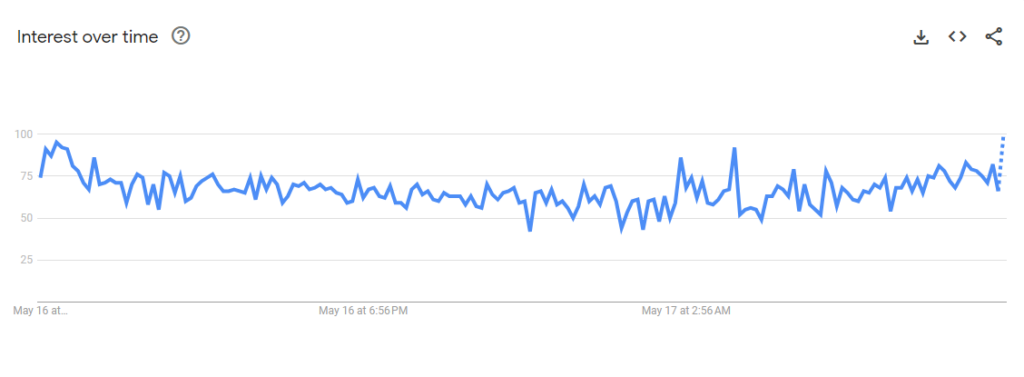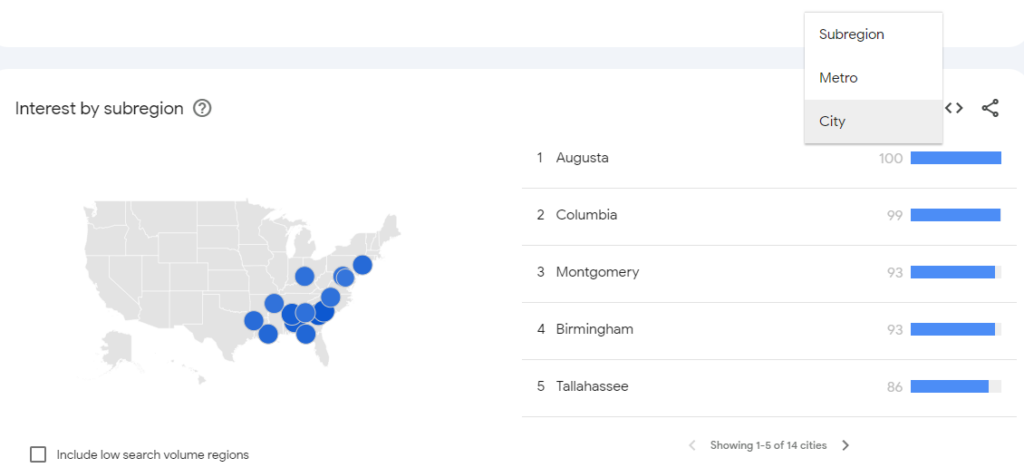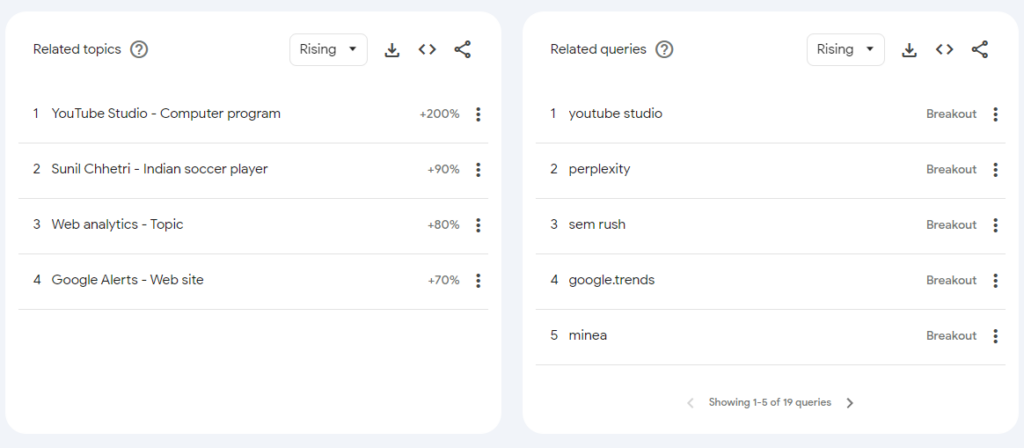Are you tired of feeling like you are always one step behind in the ever-changing world of SEO? As someone who has been in this field for years now, I can understand how frustrating it can be to stay ahead of the curve.
I have found that using powerful tools like Google Trends can have an incredible effect on your SEO strategy, whether you are trying to forecast trends over a period of time, create evergreen content, or just set realistic goals.
So, let’s dive into how to use Google Trends for SEO, from the basics, to some advanced techniques that will really give you an SEO edge.
What Is Google Trends?
At its core, Google Trends is a keyword tool that lets you explore how popular certain search queries have been over time. It also lets you explore a keyword’s popularity over time for different regions.
These valuable insights let you identify trends and make informed decisions that will impact your online visibility by allowing you to stay ahead of your competition.
What Sets Google Trends Apart?
In the world of search engine optimization, everyone is always trying to stay ahead. People have developed a myriad of different tools to help them do just this.
Google Trends, however, has set itself apart from other SEO tools by providing real-time data on the increase in search frequency for various keywords.
Google is one of the most popular search engines in the world, with about 91.54% of all online traffic in 2024. Google Trends retrieves its information directly from Google’s database of search queries.
This means that the information is not only incredibly accurate but also very comprehensive and can be used to extrapolate information from other search engines.
Another big advantage of using Google Trends as a tool for keyword research is the fact that it is very easy to use. The user-friendly dashboard includes customizable filters and categories that are intuitive, giving the platform very little learning curve.
The information is then displayed in visualizations that you can interact with, and further information like ‘related queries,’ is easy to find.
Lastly, Google Trends provides information on most topics or industries. There do not seem to be any obvious limitations despite the fact that it is completely free. This makes it suitable for you regardless of your niche, occupation, or budget.
How to Use Google Trends for SEO
1. Perform Keyword Research Using Search Volume
Keyword research is one of the basics of any SEO strategy. Google Trends can be a very powerful keyword research tool if you use it correctly.
Simply enter a keyword or topic into the search box and view how the keyword’s popularity has shifted over a specific time frame. You should be able to identify any trends easily.

I highly recommending setting the time perdiof to at leat the last 12 months, or even longer, as this helps you understand the keyword’s growth better.
You can do this for the most popular search terms that have a fair amount of traffic, allowing you to make informed decisions about your SEO strategy.
You can decide if it makes sense for you to create content on a specific keyword, or even an entire industry.
2. Build Topic Clusters
Topic clusters are usually part of a semantic SEO strategy where you organize your content around a central topic, making sure to cover all aspects and linking them all together.
This is an invaluable technique for all content marketers to build a content plan that will ensure you cover a topic comprehensively.
Google Trends can be used as a keyword research tool to help you identify these trending topics and subtopics and build a content strategy targeting content that will resonate with your current audience.
This means greater engagement and an increase in website authority.
For more information on topic clusters, you can check out this step-by-step guide.
3. Improve Your YouTube SEO
YouTube is the second largest search engine in the world, with over 2.5 billion monthly users. Additionally, it is a Google subsidiary.
This means that Google Trends can help you with your YouTube SEO optimization by helping you find niche keywords that you can use in video titles, descriptions, and tags.
Simply change the ‘Web search’ to ‘YouTube Search’ for platform-specific information.
Optimizing the videos that you are creating can help you take advantage of trending search terms related to your niche.
Using Google Trends alongside Google News can help you identify newsworthy topics for your YouTube channel, ensuring your content is both timely and relevant.
This will help you create video content when it is more likely to get a lot of views, increasing the video’s standing with the YouTube algorithm.
4. Optimize Your Local SEO Strategy
If you have a local business, then Google Trends can help you attract customers in your area. You can use the platform to analyze local trends and identify local keywords.

You can then use this information by incorporating the relevant keywords in location-specific pages or by adding them to your Google Business Profile.
Additionally, the fact that you can search for trends specifically on Google Shopping in addition to searching only in specific geographic locations means that you can optimize your local SEO to showcase products to certain customers.
You can optimize your Google Shopping listings to improve their visibility to the right people and increase your sales as well as your online reputation.
5. Leverage Seasonal Trends
Seasonal trends can help your SEO efforts. You can use them to identify how you can attract more traffic to your website at certain times.
Once you have identified keywords that you think are going to spike in traffic at a certain time, you can tailor your content or your marketing campaigns, such as Google Ads, for trending searches at the right time.
Identifying seasonal keyword ideas and trends allows you to adjust your content calendar, ensuring that relevant topics are covered at the right time to maximize engagement.
6. Leverage Trending Topics for Social Media Content
Social media is a powerful tool to help you drive traffic to your website. However, trends shift very quickly in most of them. So, you can use Google Trends in combination with something like Google News to figure out when popular keywords are starting to trend.
This will help you create a piece of content that is relevant and resonates with your audience to help you build engagement. If you are unsure, you can also see if a trend is already over, preventing you from wasting time that you could have used on better things.
Finding Breakout Trends
Breakout keywords occur when the growth of a phrase is more than 5000%. It is an amazing opportunity. But, these upward trends can be difficult to identify.
Google may not have enough data to determine growth, and using additional tools may not work as they won’t have information on them yet. It is impossible to educate yourself so that you can trust your gut on these.
7. Monitor How You Stack Up Against Your Competitors
In the big game of SEO, everyone is always trying to do better than one another and rank a little higher. Ultimately, everyone deals with the same search engine algorithms and web crawlers. So, using Google Trends to keep up with your competitors is very important.
You can use Google Trends to compare your website’s search performance to your competitors, and figure out where you can improve to boost your search engine ranking.
Advanced Techniques with Google Trends
Now that we’ve covered the basics of how to use Google Trends for SEO let’s look at some of the more advanced features that the online tool offers and how you can use these advanced techniques to your benefit.
Use Google Trends Search Operators
Using Google Trends search operators feels like you have unlocked some sort of secret code. They are very intuitive to use, but if you don’t know about them you might miss out greatly.
Leveraging these operators can help you filter results to focus on current events, ensuring your content is as relevant as possible.
Some operators that you can try out are “AND,” “OR,” and “NOT.” These will help you refine your search, especially when combined with filters and categories tabs.
Discover Insights From Time-Based Trends
Timing is very important for SEO. You can analyze historical data to identify long-term trends that are likely to carry on into the future.
Or, as mentioned above, you can see when shorter-term trends are just starting out to make the most of emerging opportunities or see when they are over so you don’t waste your time and resources.
Related Topics And Queries
When you type in a target keyword, Google Trends automatically displays the related topics and related queries, which can give you plenty of keyword ideas.

These related search phrases can help you build your topical map and also better identify search intent. Both of these will help you build better content that minimizes your bounce rate and increases your overall engagement.
I personally like to start broad, using a main term. Then, I go down a rabbit hole of related queries. The only issue I have run into is when you get to the really long-tail keywords, as there is not always a lot of data.
But, even so, it is great to build ideas.
Keywords By Category
You can use Google Trends in a slightly more advanced way by identifying common themes and topics in your larger niche.
Instead of creating content for these relatively broad themes and topics, you can use them to streamline your keyword categorization and navigation.
This will let you attract more targeted traffic for a range of queries.
Identify Keyword Data By Geography
Making use of the ability that Google Trends has to analyze keyword data by geography is not only useful for local SEO if you are running a business. Instead, it can also be used to tailor your content to certain geographic regions.
It can help you consider whether you need to incorporate certain cultural nuances or what language preferences your larger target audience may have.
By taking this information into account, you will inevitably enhance your visibility in local search results, but you will also improve readability and engagement for the resulting traffic.
Target Search Intents With Search Types
You can use Google Trends to explore different search types. This includes web search, image search, news search, YouTube search, and even Google Shopping.
By taking this information into account when looking at certain queries or keywords, you can tailor your content strategy by figuring out search intent; informational, navigational, transactional or commercial.
This will help you determine what type of content you should be creating. Blog posts or articles may be more suitable in some cases, while videos or infographics might be better for others.
Join 900+ to receive a weekly SEO video from my YouTube channel, which I’ll share, and an actionable SEO tip every week.
Wrap-Up
Google Trends is a game-changer if you want to elevate your SEO strategy. You can not only research specific keywords and optimize your content clusters but can also identify long and short-term trends.
By leveraging all of the information from Google Trends, you can create timely and relevant content, such as blog posts or social media posts, as part of a very effective content marketing strategy.
There is very little learning curve, and it is completely free, so there really is no reason that you should not at least try it.
If you are interested in staying in the loop when it comes to SEO, I highly recommend checking out some SEO newsletters and podcasts. Whether you are just kicking off your SEO career or are a seasoned professional, there is always more to learn about content creation in this ever-changing field.
FAQ
How to find keywords from Google Trends?
To find keywords using Google Trends, simply enter a topic or keyword into the search bar and explore the related queries and topics section. You can also use filters to narrow down your results by location, time period, category, and more.
What is 100 in Google Trends?
In Google Trends, a value of 100 represents the peak popularity of a search term or topic within a specific time period and location.
How accurate are Google Trends?
Google Trends provides valuable insights into search trends and user behavior, but it’s important to interpret the data with caution. While Google Trends can help identify patterns and trends, it may not always accurately reflect actual search volumes or user behavior.
What are some good alternatives to Google Trends?
While Google Trends is an excellent tool for SEO and market research, there are several alternatives worth exploring. Some popular alternatives to Google Trends include SEMrush, Ahrefs, Moz Keyword Explorer, and Ubersuggest.


